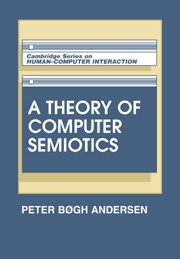 A Theory of Computer Semiotics
A Theory of Computer Semiotics Preface to second edition
Published online by Cambridge University Press: 26 March 2010
Summary
What is computer semiotics?
Semiotics is the science of signs and their life in society. A sign is anything that stands for something else for someone.
Semiotics treats all kinds of signs: verbal language, pictures, literature, motion pictures, theater, body language. Computer semiotics is a semiotic discipline that studies the nature and use of computer-based signs.
The motivation for the discipline comes from the nature of computer systems: although in many respects computer systems can be conceived as tools in analogy with typewriters, pencils, brushes and filing cabinets, they differ from these tools by not primarily existing or being used as physical objects, but as signs. The pencil of the drawing program is no real pencil that can be used to chew on, it is merely stands for a pencil, represented by a collection of pixels on the screen. Computer systems resemble other media by primarily acting as carriers of meaning.
Even if computer systems basically are symbolic tools, this symbolic nature has only attracted serious attention in recent years.
The reason for this is threefold: from being a tool only for specialists, computers have now been integrated into many occupations, and therefore the demands for interpretability have risen. The mode of operation and the meaning of the data must be easy to grasp for the secretary or the manager whose time should not be spent deciphering cryptic codes but writing agendas or making decisions. A good interface has become a necessary prerequisite for a good system.
- Type
- Chapter
- Information
- A Theory of Computer SemioticsSemiotic Approaches to Construction and Assessment of Computer Systems, pp. 1 - 26Publisher: Cambridge University PressPrint publication year: 1991


